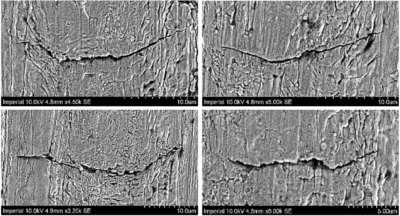Founder of TriboNet, Editor, PhD (Tribology), Tribology Scientist at ASML, The Netherlands. Expertise in lubrication, friction, wear and contact mechanics with emphasis on modeling. Creator of Tribology Simulator.
Rolling Contact Fatigue
Rolling-contact fatigue (RCF) is defined as a failure or material removal driven by crack propagation caused by the near-surface alternating stress field. It is typically considered that if a bearing is properly mounted, aligned, lubricated, maintained and not overloaded, then the material fails due to RCF [1]. RCF is also commonly observed in gears, camshaft mechanisms, and rail-wheel contacts and is considered being the most unavoidable failure in the rolling contacts.
RCF may appear through subsurface originated spalling and/or surface originated pitting. The dominant mechanism depends on a number of factors, e.g., surface quality, lubricant cleanliness, material quality. Spalling occurs due to propagation of microcracks originated below the surface. The microcracks develop at material inhomogeneities (like inclusions) and propagate towards the surface. Smooth surfaces, abundance of the nonmetallic inclusions in the material, and absence of surface shear are the key factors to favor this failure mode. On the other hand, pitting occurs due to surface roughness, which acts as stress raisors and facilitate the crack initiation. Further it propagates at a shallow angle 15–30 deg to the surface and afterwards back towards the surface. This mechanisms is common for the sliding contacts with substantial surface to surface contacts.
RCF differs from the classical fatigue due to several characteristic conditions [2]:
1. The state of stress in nonconformal contacts is complex and multiaxial and governed by the Hertzian contact theory.
2. The loading history at a point below the surface is nonproportional; i.e., the stress components do not rise and fall with time in the same proportion to each other;
3. There is a high hydrostatic stress component present in the case of nonconformal contacts.
4. The phenomenon of RCF occurs in a very small volume of stressed material. Typical contact sizes are of the order of 200–1000 ![]() .
.
5. Localized plastic deformation and development of residual stresses play crucial role in the fatigue damage, and the 3D modeling techniques to compute these quantities is important for calculation of RCF damage.
References
- [1] Rolling Bearing Analysis: Essential Concepts of Bearing Technology, 5-th Edition, T.A. Harris, M.N.Kotzalas.
- [2] A Review of Rolling Contact Fatigue, Farshid Sadeghi et al., DOI: 10.1115/1.3209132 .

Be the first to comment